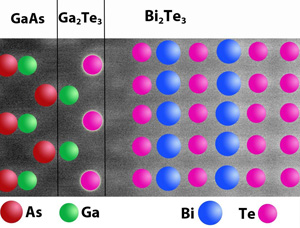Mar
12
Solving the Puzzle of Binding Two Unusual Materials
March 12, 2013 | 1 Comment
A thin film of bismuth telluride (Bi2Te3) on top of gallium arsenide (GaAs) converts heat into electricity or electricity to cooling creating cooling devices for electronics or generating electricity from heat sources.
Dr. James LeBeau, an assistant professor of materials science and engineering at NC State and co-author of the paper on the research in Applied Physics Letters explains, “We’ve used state-of-the-art technology to solve a mystery that has been around for years, and now that we know what is going on, we can pursue research to fine-tune the interface of these materials to develop more efficient mechanisms for converting electricity to cooling or heat into electricity. Ultimately, this could have applications in a wide range of electronic devices.”

Bismuth Telluride Gallium Arsenide Bond Diagram. Researchers have found that the two materials are actually separated by a thin layer of a hitherto unsuspected third material. Click image for the largest view.
To study the phenomenon, the researchers had to create the nanometer-scale thin films on a GaAs substrate, or foundation. The GaAs is first placed in a vapor deposition chamber. Molecules containing bismuth and tellurium are then introduced into the chamber, where they react with each other and “grow” into a crystalline Bi2Te3 structure on the surface of the GaAs.
Using advanced “Super-X” X-ray spectroscopy technology in conjunction with an aberration-corrected scanning transmission electron microscope, the researchers were able to determine what was binding the Bi2Te3 to the GaAs – and it was not what they were expecting.
They found that when the tellurium molecules were introduced to the vapor deposition chamber, the tellurium reacted with the GaAs substrate to create a new surface layer of gallium telluride, which was only one molecule thick. The Bi2Te3 then formed a thin film on top of that new surface layer.
Because gallium telluride does not react with Bi2Te3, the research team knew chemical bonding could not be holding them together. Instead, the two layers are held together by the weaker force of van der Waals bonds – meaning the materials are held together by weak electrical forces.
“While these materials have been investigated previously by RTI and NC State, the state-of-the-art techniques applied by LeBeau and his team have revealed significant new insights into how the film grows,” notes Dr. Rama Venkatasubramanian of RTI International, who is also a co-author of the paper.
Recovering the heat and transforming it back into a useful form could become a major source of energy. Humanity vents off enormous amounts of heat back into the atmosphere and off into space. Its money already spent for the original energy source and would be cost free before the means to recovery is applied. The calculation is little different than most all ‘renewables’
The work at NC State is welcome indeed. The technology may not be destined for huge installations, but cheap and installed by the millions or billions it would really add up.
Comments
1 Comment so far


I was astounded to find the research into this subject. It has the promise to recover a significant amount of wasted energy when you consider the tens of billions of electronic components and devices that have to dissipate heat. Being able to recover that energy and turn it into a useful energy source would be a major milestone. Outstanding work!